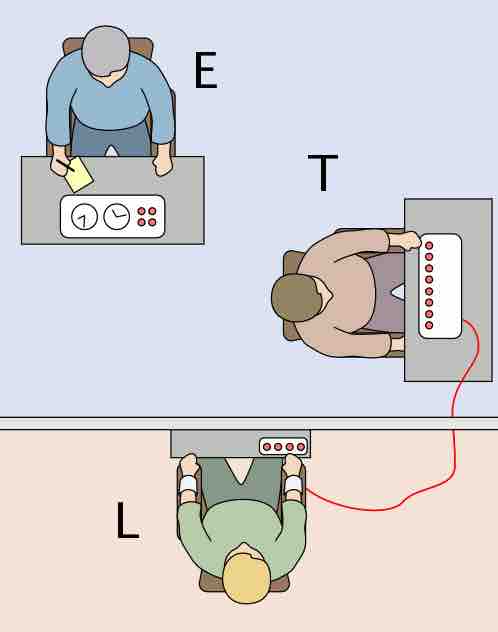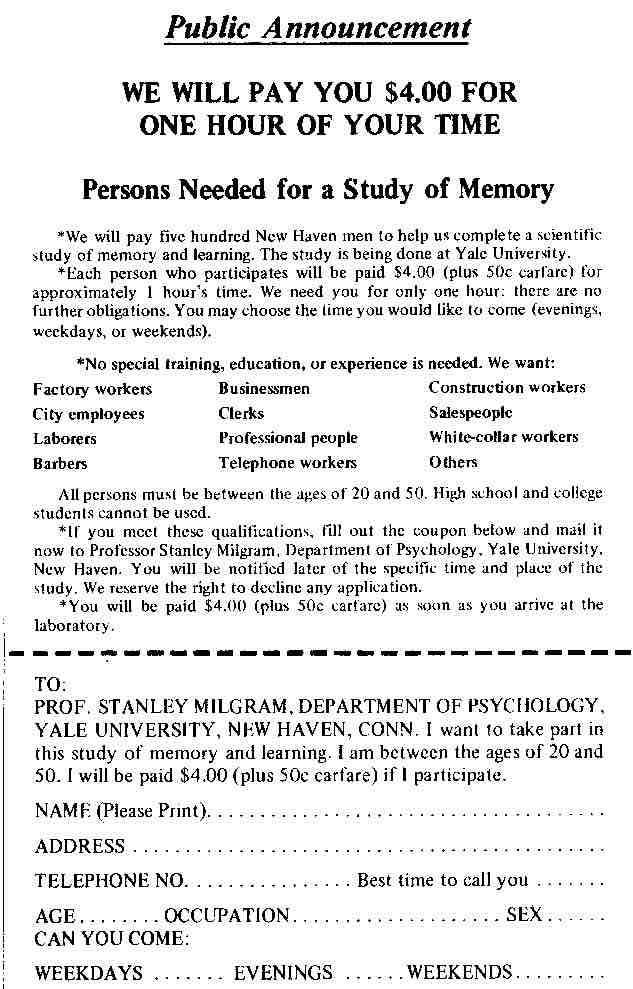The Milgram experiment—based on obedience to authority figures—was a series of notable social psychology experiments conducted by Yale University psychologist Stanley Milgram in the 1960s. It measured the willingness of study participants to obey an authority figure who instructed them to perform acts that conflicted with their personal conscience.
Milgram devised his psychological study to answer the question of whether the millions participating in the Holocaust actually consciously shared the intent of its genocidal goals. Milgram's experiments suggested that the millions of accomplices were merely following orders, despite violating their moral beliefs.
The Milgram Experiment was also quite controversial, and considered by many scientists to be unethical and physically or psychologically abusive, motivating more thorough review boards and committee reviews for research with human subjects.
The Experiment
The volunteer subject used a list of word pairs to play the role of "teacher" with another participant, the "learner". In reality, the learner was a confederate working for the experimenter and only acting as a participant. The naïve participants drew slips of paper to determine their roles, but unknown to them, both slips said "teacher," and the confederate always claimed to have the slip that read "learner. " At this point, the "teacher" and "learner" were separated into different rooms where they could communicate but not see each other.
The teacher began by reading the list of word pairs to the learner. They would read the first word of each pair and four possible answers. The learner would press a button to indicate his response. If the answer was incorrect, the teacher was instructed administer an electric shock to the learner, with the voltage increasing in 15-volt increments for each wrong answer. If correct, the teacher would read the next word pair.
The teacher was given an electric shock from the electro-shock generator as a sample of the shock that the "learner" would supposedly receive during the experiment. The subjects believed that for each wrong answer, the learner was receiving actual shocks. In reality, there were no shocks. After the confederate was separated from the subject, the confederate set up a tape recorder integrated with the electro-shock generator, which played pre-recorded sounds for each shock level.
In one version of the experiment, the confederate told the participant that he had a heart condition. After a number of voltage level increases, the confederate started to bang on the wall that separated them from the participant. After several times banging on the wall and complaining about their heart condition, all responses by the learner would cease.
At this point, many people indicated their desire to stop the experiment and check on the learner. Some test subjects paused at 135 volts and began to question the purpose of the experiment. Most continued after being assured that they would not be held responsible.
If at any time the subject indicated his desire to halt the experiment, he was given a succession of verbal prods by the experimenter, in this order:
- Please continue.
- The experiment requires that you continue.
- It is absolutely essential that you continue.
- You have no other choice, you must go on.
If the subject still wished to stop after all four successive verbal prods, the experiment was halted. Otherwise, it was halted after the subject had given the maximum 450-volt shock three times in succession .

The Milgram Experiment Setup
The experimenter (E) orders the teacher (T), the subject of the experiment, to give what the latter believes are painful electric shocks to a learner (L), who is actually an actor and confederate. The subject believes that for each wrong answer, the learner was receiving actual electric shocks, though in reality there were no such punishments. Being separated from the subject, the confederate set up a tape recorder integrated with the electro-shock generator, which played pre-recorded sounds for each shock level.
Results
Before conducting the experiment, Milgram polled fourteen Yale University senior-year psychology majors to predict the behavior of 100 hypothetical teachers. All of the poll respondents believed that only a very small fraction of teachers would be prepared to inflict the maximum voltage.
In Milgram's first set of experiments, 65 percent (26 of 40) of experiment participants administered the experiment's final massive 450-volt shock, though many were very uncomfortable doing so. At some point, every participant paused and questioned the experiment, some saying they would refund the money they were paid for participating in the experiment.
Interpretations
Professor Milgram elaborated two theories explaining his results:
- The first is the theory of conformism, based on the Solomon Asch conformity experiments, describing the fundamental relationship between the group of reference and the individual person. It states that a subject who has neither ability nor expertise to make decisions, especially in a crisis, will leave decision making to the group and its hierarchy.
- The second is the agentic state theory, where, according to Milgram, "the essence of obedience consists in the fact that a person comes to view themselves as the instrument for carrying out another person's wishes, and they therefore no longer see themselves as responsible for their actions..."

Milgram Experiment Advertisement
Image of the original advertisement posted to solicit study participants for the Milgram experiment.